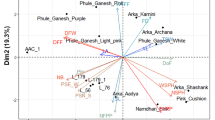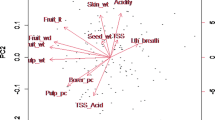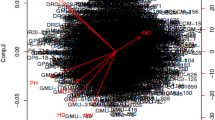Abstract
The presence of a narrow genetic base is the major bottleneck in improvements in litchi to get desired objectives. Studies on the nature and extent of genetic diversity are directly related to yield and quality, which can be used in a breeding programme for genetic improvement. In the present study, 30 litchi genotypes were assessed with respect to variability, heritability and genetic advance based on 39 quantitative traits. Results revealed that phenotypic coefficients were lower than their corresponding genotypic coefficients suggesting an inherent relationship among them. High phenotypic and genotypic coefficients of variation were recorded for flavonoids in seeds (132.39 and 132.38%), flavonoids in the pericarp (116.89 and 116.86%), phenolics in the pericarp (97.84 and 97.83%), anthocyanin in the pericarp (55.73 and 55.54%), female flowers (53.08 and 52.98%), total chlorophyll (51.07 and 50.99%), phenolics in seeds (48.60 and 48.58%), number of fruits per cluster (44.94 and 44.73%), tree volume (38.80 and 38.70%) and panicle length (28.15 and 19.92%). Broad-sense heritability was more than 80% for all the traits except trunk girth, leaflet width, panicle length and titratable acidity. Heritability and genetic advance were found to be maximum for female flowers (%), phenolics and flavonoids content. A high coefficient of variation was observed for female flowers (%), number of fruits per cluster, phenolics and flavonoids. The grouping of genotype based on combined qualitative and quantitative traits presented more accurate results. This will help to select distant diverse genotypes in the hybridization programme in order to get more diverse progenies.



Similar content being viewed by others
References
Bajpai A, Muthukumar M, Singh A, Nath V, Ravishnkar H (2016) Narrow genetic base of Indian litchi (Litchi chinensis) cultivars based on molecular markers. Indian J Agric Sci 86(4):448–455
Burton GW (1952) Quantitative inheritance in grasses. Proc. 6th Int. Grassland Congr. 1:277–283
Habindavyi E (2009) Morphological characterisation of sorghum (Sorghum bicolor) diversity in Burundi. CBM master’s thesis, vol 55, p 48 (SLU, Swedish Biodiversity Centre)
Illoh HC, Olorode O (1991) Numerical taxonomic studies of Nigerian mango varieties (Mangifera indica L.). Euphytica 40:197–205
Johnson HN, Robinson HF, Comstock RE (1955) Estimates of genetic and environmental variability in soybean. Agron J 47:314–318
Lal N, Singh A, Kumar A, Marboh ES, Gupta AK, Pandey SD, Nath V (2022) Genetic variability, correlation and path-coefficient studies in litchi (litchi chinensis Sonn.) for plant growth, panicle and yield attributes. Int J Bioresour Stress Manag 13(1):29–36
Marboh ES, Gupta AK, Gyanesh K, Singh M, Singh A, Nath V (2018) Genetic variability, heritability and genetic advance in litchi (Litchi chinensis). Indian J Agric Sci 88(10):1510–1514
Pathak AK, Singh SP, Tuli R (2014) Amplified fragment length polymorphism fingerprinting to Identify genetic relatedness among litchi cultivars and markers associated with small-seeded cultivars. J Am Soc Hortic Sci 139(6):657–668
Paudyal KP, Haq N (2008) Variation of pomelo (Citrus grandis (L.) Osbeck) in Nepal and participatory selection of strains for further improvement. Agroforest Syst 72:195–204
Rai M, Das B, Nath V, Kumar M, Rai RK (2002) Fruit characteristics of litchi cultivars under Chotanagpur conditions. Orissa J Hortic 30(2):1–5
Rajan S, Yadava LP, Kumar R, Saxena SK (2009) Genetic divergence in mango varieties and possible use in breeding. Indian J Hortic 66:7–12
Singh PK, Chaudhary BD (1977) Variance and Covariance Analysis, Biometrical Methods in Quantitative Genetic Analysis. Kalyani Publishers, New Delhi, pp 200–223
Singh A, Nath V (2012) Variability in fruit physico-chemical characters of litchi (Litchi chinensis Sonn.): an index for selection of improved clones for processing and value addition. Indian J Genet Plant Breed 72(2):143–147
Singh A, Nath V (2015) Variability in fruit physico-chemical characteristics of litchi (Litchi chinensis) in Tripura and Asom. Indian J Agric Sci 85(2):261–265
Srivastava KK, Verma MK, Ahmad N, Razvi SM, Ahmad S (2014) Genetic diversity and divergence analysis in sweet cherry (Prunus avium L.). Indian J Hortic 71(2):156–161
Author information
Authors and Affiliations
Corresponding author
Ethics declarations
Conflict of interest
N. Lal, S.K. Pandey, S.D. Pandey and V. Nath declare that they have no competing interests.
Rights and permissions
Springer Nature oder sein Lizenzgeber hält die ausschließlichen Nutzungsrechte an diesem Artikel kraft eines Verlagsvertrags mit dem/den Autor*in(nen) oder anderen Rechteinhaber*in(nen); die Selbstarchivierung der akzeptierten Manuskriptversion dieses Artikels durch Autor*in(nen) unterliegt ausschließlich den Bedingungen dieses Verlagsvertrags und dem geltenden Recht.
About this article
Cite this article
Lal, N., Pandey, S.K., Pandey, S.D. et al. Genetic Diversity and Grouping of Litchi Genotypes Based on 83 Qualitative and Quantitative Traits. Erwerbs-Obstbau 65, 1003–1012 (2023). https://doi.org/10.1007/s10341-022-00747-x
Received:
Accepted:
Published:
Issue Date:
DOI: https://doi.org/10.1007/s10341-022-00747-x




